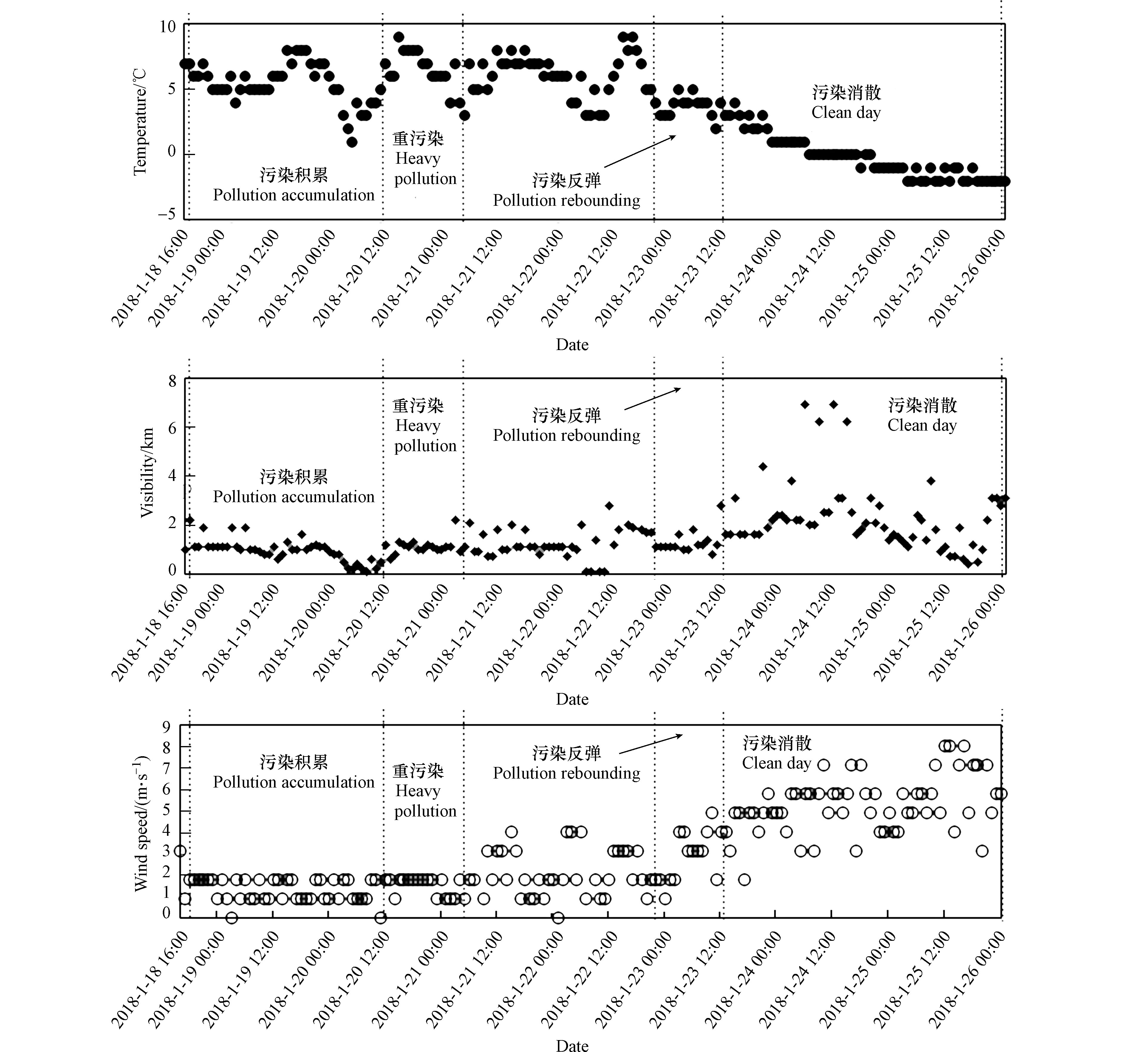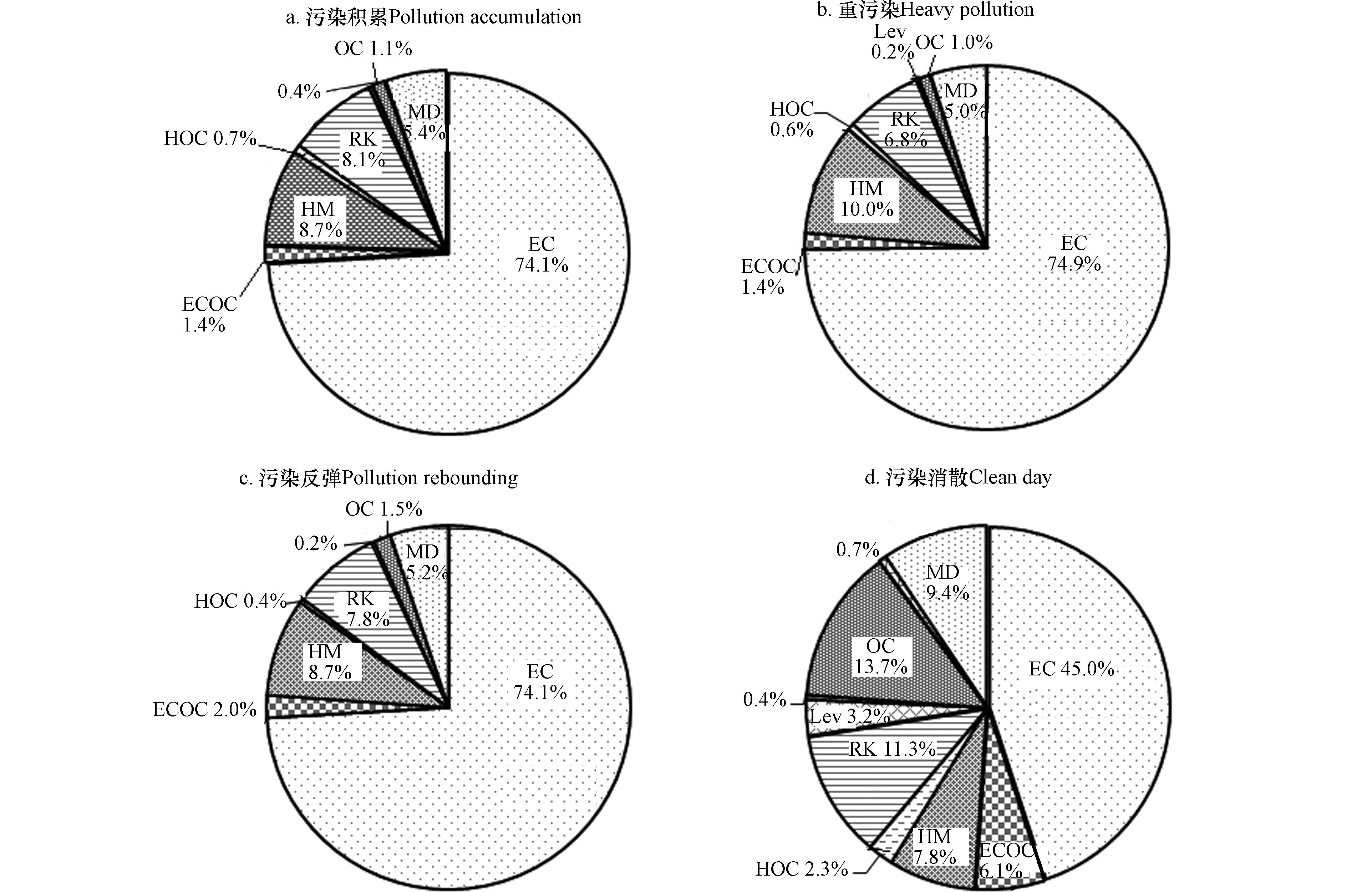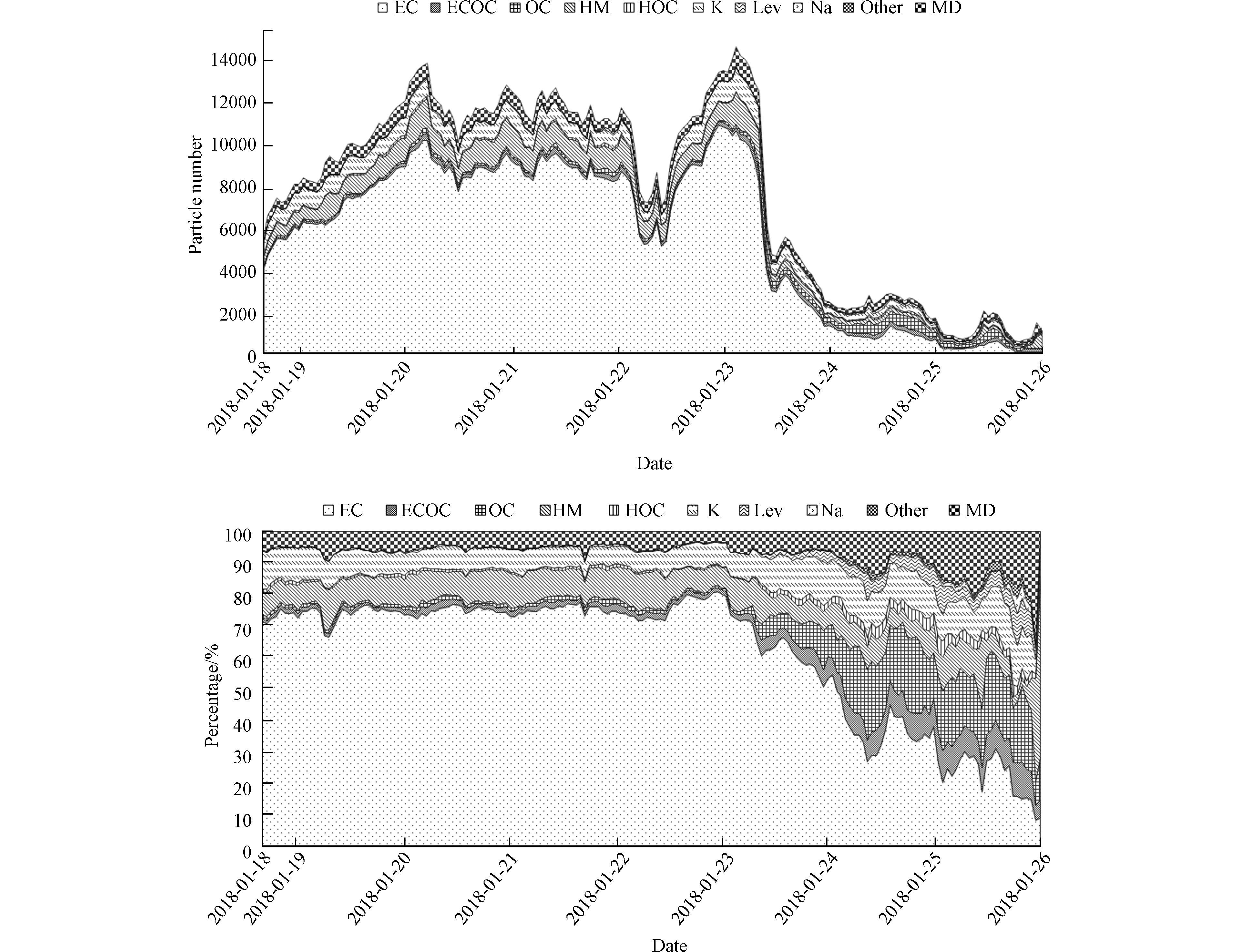-
随着城市化以及工业化进程的快速推进,空气污染也随之加重并且成为人民日益关注的热点之一[1]。大气细颗粒物作为《环境空气质量标准》(GB3095—2012)中6项污染物指标之一,从《大气污染防治行动计划》到《蓝天保卫战三年行动计划》,大气细颗粒物污染治理更是国家这几年大气污染防治的工作重点[2]。大气颗粒物通过吸收或散射太阳辐射进而对地-气系统的辐射平衡产生直接影响,另一方面也可以通过影响云凝结核的活化特性,间接改变云反照率并影响气候系统变化[3-4],细颗粒物比表面积较大,粒径较小,活性强,易富集有毒有害物质,长期暴露在颗粒物污染环境下会对人的身体健康产生巨大伤害[5-6]。颗粒物的粒径、组分以及混合态各存特征,因其来源、反应环境及过程不同而发生变化,故研究单颗粒的组分及粒径分布具有重要意义。
传统的颗粒物组分研究主要依靠对颗粒物进行离线采样及实验室分析,该种方法处理时间周期较长,不能连续真实地反映污染实况[7],因此,实时在线测量大气颗粒物组分可以了解大气颗粒物污染特征。这对分析颗粒物来源及其成因有着重要作用,同时能够对大气污染防治提供精准科技支撑。近年来合肥市二、三产业发展较快,2017年合肥市生产总值第一产业占比3.8%,第二产业占比50.5%,第三产业占比45.7%[8]。目前在合肥地区对颗粒物组分研究内容较少,主要利用离线实验室分析方法研究,如刘可可等[9]利用X射线荧光光谱法(XRF)对合肥市重污染和非污染天气下大气颗粒物中元素组成进行差异性分析;汪洋等[10]对合肥大气PM2.5中重金属元素的含量、富集系数和可能来源展开研究;施学美等[11]用热/光碳分析仪测定合肥春季大气PM10和PM2.5中有机碳、元素碳的含量,并对其来源进行初步解析。相比于离线采样分析,单颗粒气溶胶质谱仪具有时间分辨率高,灵敏度高,信息量大等优点,填补了传统方法的不足,相比其他在线分析仪器如Marga等,SPAMS侧重从单颗粒尺度获取组分特征,能更全面地解析单个颗粒物来源及混合状态等,有利于定性分析,已被国内广泛应用于颗粒物的研究[12-19]。
本文选取一次重污染天气为研究对象,在不同污染天气内测定颗粒物的粒径分布、化学组成和变化规律,并对颗粒物进行分类,通过进一步分析不同污染天气内各类颗粒物的来源和污染特征,以期为进一步开展大气细颗粒物源解析研究提供基础数据,为环境管理和污染防治对策提供科学依据。
-
(1)颗粒物化学组分采集
本研究细颗粒物化学组分特征来自单颗粒气溶胶质谱仪(SPAMS,型号0515,广州禾信仪器有限公司)的观测实验,观测点在长江西路和霍山路交叉口,合肥市长江西路10号原安徽省环保厅大院内(117.27°E,31.86°N),测点位于合肥市中心区域,周围主要是民用住宅、商用大楼和城市主干道——长江西路,无影响较大的污染源。采样口四周无遮挡物,位于地面之上5 m。
(2)颗粒物浓度数据和气象资料来源
污染物浓度数据来源于全国城市空气质量实时发布平台(http://106.37.208.233:20035/),合肥市共有10个国控监测站点,研究指标取10 个站点的小时浓度平均值。AQI计算方法和天气类型判断按照《环境空气质量指数(AQI)技术规定(试行)》(HJ 633—2012)执行。气象数据来源于中国气象数据网(http://data.cma.cn)发布的中国地面气候资料日值数据集(V3.0),该数据集已经过严格的质量控制,数据较为可靠,包括温度、风速、能见度。
-
采集的颗粒物数据使用Matlab软件的自适应共振神经网络算法(ART-2a)对颗粒物进行归类。运行3个主要参数为警戒因子、学习因子和迭代次数,分别为0.7、0.05和20[20]。
-
(1)污染阶段划分
合肥市2018年1月底发生了重污染事件,本次实验选取重污染发生的整个过程为实验观测时间,时间跨度为在2018年1月18日16点至2018年1月26日零点,图1为PM2.5观测浓度与AQI指数时间变化图,根据《环境空气质量指数(AQI)技术规定(试行)》(HJ 633—2012)规定,将AQI指数在201—300之间的天气类型定为重污染天气,并在空气质量指数大于 50 时,空气质量分指数最大的污染物为首要污染物。研究期间,首要污染物持续为PM2.5,共出现3次明显的重污染天气,分别出现在19—20日、20—21日、23—24日期间,其中20—21日出现的重污染天气持续时间长且污染重,根据不同的污染程度,划分成4个天气类型:污染积累(1月18日16:00 至 1月20日11:00)重污染期间(1月20日12:00 至1月21日1:00),污染反弹阶段(1月22日21:00 至1月23日9:00)和污染消散期间(1月23号10:00 至1月26号0:00)。
(2)污染过程分析
图2是研究期间气象参数时间变化图,污染物积累期间平均风速1.33 m·s−1,平均气温5.5 ℃,平均能见度1 km,为静稳天气,根据地面空气站点观测资料,期间PM2.5平均浓度149.7 µg·m−3,整体污染较严重,持续的污染排放积累和不利的稀释扩散条件直接导致后续持续的重污染事件;20日12时,进入重污染阶段,PM2.5质量浓度在20日21点出现全年最高值,为239 µg·m−3。AQI指数289,接近严重污染。由于不利扩散条件、污染源强的增加等原因。22日21时进入污染反弹阶段,比较重污染阶段,此次污染程度较轻,持续时间短。23日凌晨,来自北方的冷空气开始持续影响合肥地区,最高风速达到8 m·s−1,扩散条件较好,气温下降,能见度提高,消散期间平均PM2.5小时浓度为46.3 µg·m−3。平均AQI指数64,空气质量良。
观测期间SPAMS每小时捕捉到的颗粒数以及PM2.5的监测数据二者之间变化趋势如图3所示,可知二者之间变化基本一致,相关系数为0.85,可见PM2.5数浓度与PM2.5质量浓度具有一定的对应关系,由于PM2.5采用的合肥市10个站点的平均值,而SPAMS在车流量较大干线旁固定点采样,故SPAMS捕捉到的峰值明显高于PM2.5监测数据,说明SPAMS检测到的细颗粒物可以在一定程度上反映颗粒物污染程度
-
图4所示为获得的9类颗粒的平均质谱图,其中Pos为元素正谱图,Neg为负谱图。图4(a)为元素碳(EC)类颗粒物,其正负谱图中含有信号较强的碳族元素,即C+、
${\rm{C}}_3^ + $ 、${\rm{C}}_4^ + $ 、${\rm{C}}_5^ + $ 、${\rm{C}}_2^ - $ 、${\rm{C}}_3^ - $ 、${\rm{C}}_4^ - $ 和${\rm{C}}_5^ - $ (m/z = 12、36、48、60、−24、−36、−48、−60)谱图中也有较高的${\rm{NO}}_3^{-} $ (−62)、(−80)和${\rm{HSO}}_4^{-} $ (−97)指示,说明该颗粒在传输过程中经历了二次反应,经历较长的传输老化过程[21]。元素碳可以作为化石燃料的示踪物,已有研究结果表明该颗粒物主要是由机动车尾气造成[22]。图4(b)为有机碳(OC)类颗粒物,在正谱图中主要含有
${{\rm{C}}_2}{\rm{H}}_2^ + $ (26)、C3H+(37)、C2H3O+(43)、${{\rm{C}}_4}{\rm{H}}_3^ + $ (51)、${{\rm{C}}_5}{\rm{H}}_3^ + $ (63)、${{\rm{C}}_6}{\rm{H}}_5^ + $ (77)等有机信号碳峰,此外,会伴有硝酸盐和硫酸盐等二次组分的存在,经过了一定的老化过程。指示有机碳类颗粒物可能来源于一次有机物排放源如生物质燃烧排放、燃煤[23],李莉等[24]在对上海市重污染天气源贡献分析中也发现有机碳主要来源于挥发类源、移动源和扬尘源,占比可达80%。图4(c)为元素碳有机碳混合碳(ECOC)颗粒谱图,同时含有元素碳和有机碳颗粒物质谱特征,且元素碳的特征峰较明显。研究表明ECOC颗粒物可能由于二次有机物在EC颗粒表面吸附混合而形成[21],来源与元素碳和有机碳相似。图中硝酸盐及硫酸盐峰值较其他谱图明显,说明OCEC颗粒经历了较长时间的老化过程。图4(d)为富钾(RK)颗粒,分类主要参考其谱图中K+(39)信号明显高于其他信号,图4(e)为富钠(RNa)颗粒,分类主要参考其正谱图中Na+信号明显高于其他信号,另外还含有
${\rm{C}}_3^ + $ (36)、${{\rm{C}}_5}{\rm{H}}_3^ + $ (63)等EC及OC颗粒特征峰信号。研究认为富钾及富钠的来源较多[25],可能包括机动车尾气排放、海盐、生物质燃烧和工业工艺等源头。图4(f)为矿物质颗粒物(MD)谱图,通常其中含有地壳元素如Na+(23)、Mg+(24)、Al+(27)、Fe+、Ca+(40)、Fe+/CaO+(56)、${\rm{SiO}}_3^ - $ (−76)等特征峰,主要来自扬尘源。韩力慧等[26]对北京地面扬尘进行采样分析认为扬尘除了来自地壳源的部分外,还存在来自人为源的部分。大气中的颗粒物通过干湿沉降进入地面进而影响了地面扬尘的组分含量。富Fe颗粒物一般来源于土壤自然源和人为排放源钢铁冶炼等能源工业排放[27]。Al+为扬尘颗粒的主要成分,Al和其他金属的比值可以用来指示扬尘颗粒[28]。图4(g)为左旋葡萄糖颗粒物(Lev)谱图,正谱图有明显的K+信号且具有较常见的有机峰,但峰面积较OC颗粒正谱图有机峰低,其负谱图上有CN−(−26)及硫酸盐和硝酸盐等二次组分信号峰,左旋葡萄糖颗粒物主要来自于生物质燃烧。
图4(h)为重金属(HM)颗粒物谱图,包含Mn+(55)、Fe+(56)、Pb+(206/207/208)等明显的金属离子信号。Pb+颗粒可指示工业源排放[29],值得注意的是Pb+颗粒与Fe+颗粒存在一定的相关性,两者之间可能具有一些相似的排放源[30-31]。
图4(i)为高分子有机碳(HOC)颗粒质谱图,质谱图中除了含有OC等低分子有机碳以外,还存在一些高分子有机碳,认为该种高分子有机碳主要来自于腐殖质(HULIS)或者多环芳烃(PAHs)[32]。图4(j)为其他类颗粒质谱,主要K+和Na+信号峰较明显,同时也含有其他离子。
图5为污染积累、重污染、污染反弹和污染消散期间各类颗粒物的占比,从中可见,不同污染程度下,各颗粒物类型占比有着明显的差别,重污染期间,EC、HM、MD及RK颗粒占比显著,分别平均占74.9%、10.0%、5.0%和6.8%,几种颗粒类均有二次离子如
${\rm{NO}}_3^{-} $ 、${\rm{HSO}}_4^{-} $ 等组分特征,说明在污染期间颗粒物的老化比较明显,经历的化学过程较长,颗粒物的混合凝并等现象比较突出。与重污染期间不同,污染消散期间各组分占比较均匀,由于气象条件的好转,EC颗粒占比降低约29.9%,HM颗粒降低2.2%。OC颗粒物占比增长约12.7%,ECOC颗粒增长4.7%,HOC颗粒增长1.7%;由于风速增大,MD颗粒占比增加4.5%。 -
颗粒物粒径分布可以在一定程度上反映颗粒物的老化状态,在传输过程中颗粒物经历了一系列复杂的化学反应导致了其组分变化从而具有不同的粒径分布,研究颗粒物的粒径分布,有助于识别各类颗粒物的来源,图6所示为重污染和污染消散期间颗粒数的粒径分布,重污染期间,细颗粒物总数峰值出现在0.8 μm,OC与Lev颗粒峰值出现在0.48 μm。其余化学组分峰值均在0.74—0.84 μm之间,与细颗粒物总数分布规律相似;在污染消散期间,细颗粒峰值出现在0.7 μm,峰值粒径减小0.1 μm,EC、HM、HOC、RK颗粒峰值粒径分别下降0.04、0.02、0.36、0.22 μm,下降幅度较大, MD颗粒增大0.08 μm,OC和Lev颗粒峰值粒径未改变。
当新鲜的粒子排入大气并逐步老化时,其表面不断附着
${\rm{NH}}_4^{+} $ 、${\rm{SO}}_3^{-} $ 、${\rm{SO}}_4^{-} $ 等二次组分,颗粒粒径在逐步增大 [17]。HOC、RK颗粒在进入污染消散期间后,粒径下降幅度最大,说明二者在重污染期间老化状态严重,平均谱图中高硝酸盐及硫酸盐指示也证实了这点。EC颗粒峰值粒径下降说明其也经过了老化过程,有学者认为随着二次有机物在EC颗粒表面的吸附,形成ECOC混合态[33]。重污染期间,EC颗粒占比74.9%,HM占比10.0%,RK占比6.8%,且HM、HOC、RK颗粒谱图中均出现了元素碳族特征。说明本次重污染主要污染物为元素碳类型颗粒物。 MD颗粒主要来源于地壳,表征扬尘源头,MD颗粒占比随着粒径的增大而增大,在2 μm附近占比最大,说明粗粒径中主要是扬尘类颗粒物,扬尘类颗粒数占总数3.7%,重污染期间风速低,扬尘污染较轻。污染消散期间,风速增大,对地面扬尘吹撒作用增强,卷带起较大粒径颗粒,故MD颗粒粒径略有增大。对比不同污染期间,OC及Lev颗粒粒径趋势改变较小,且峰值粒径均在0.48 μm,颗粒数重污染期间占比较小,在污染消散期间占比增大,推测为附近地区生物质或燃煤燃烧,在扩散条件较好时,扩散至测点周围被仪器捕捉。 -
图7是观测期间颗粒物组分时间序列上的变化图,在污染积累阶段,PM2.5平均浓度为151.7 μg·m−3,细颗粒物污染较重,在此期间SPAMS捕捉的颗粒数也在不断增加,颗粒物捕集速率于1月20日4点到达峰值,稍早于PM2.5质量浓度峰值,PM2.5每小时捕集颗粒数主要由SPAMS单独测得,主要针对测点周围,而PM2.5质量浓度代表合肥市均值,故二者之间略有差别。由百分比图知各组分比例基本维持稳定,EC颗粒占比最大,RK颗粒、HM颗粒、扬尘类颗粒占比次之,几类颗粒物由于不利气象条件而积累,直接造成后续重污染天气形成。
进入重污染阶段,EC颗粒占比仍高居不下,RK和HM颗粒占比也较高,从平均谱图中看出,RK及HM颗粒均出现较明显的元素碳特征峰,推测三者存在同一排放源头,道路机动车化石燃料燃烧会排放大量元素碳类颗粒[22],加之不利的气象在夜间恶化,导致细颗粒物积累混合老化,部分转变为衰老的RK及HM颗粒,EC颗粒本身也处于老化状态,重污染期间主要风向为东风,风速较小,温度较低,能见度由于高浓度气溶胶的影响从始至终处于较低水平。
重污染过后,空气质量开始略微好转,除风速有些许提高外,气象条件依然保持不变,源头排放强度减弱稍微缓解颗粒物污染,各组分的占比依然没有大幅度改变。22日11点,污染物浓度再次由降转升,进入污染反弹阶段,SPAMS捕集的颗粒数于23日凌晨3时达到污染期间最高值,整体同第一次重污染相似,颗粒物组分没有太大变化,平均浓度155 μg·m−3,污染较严重。
23日中午,来自北方的清洁冷空气气团开始影响合肥地区,主要风向为东北向,风速最大可达8 m·s−1,整体气温下降至零度左右,能见度由于污染的减轻有大幅度提高,空气质量转好。相比于污染时间段,污染消散期间EC颗粒的占比下降约29.9%,HM下降约2.2%,变化没有EC颗粒明显,说明二者不完全是同一个来源;由于地面风速的增加,加大了扬尘源的强度,扬尘类颗粒上升约4.5%。
对时间序列上的各组分颗粒物之间以及组分与气象因素之间的进行相关性分析,如表1、2所示,各组分之间均有较好的相关性,根据表1,可以发现EC、HM、K、MD颗粒之间在0.01 水平(双侧)上显著相关,相关系数都在保持在0.8以上,说明4种变化趋势相似,可能由同一种因素引起。EC、HM、K颗粒可能来自机动车尾气的排放造成;由于设备所在地车流量很大,车辆行驶会卷起扬尘,造成MD颗粒的增高。这也验证了此次重污染的主要污染源是机动车内源排放造成。结合表2,EC、HM、K及MD4种颗粒物与风速有呈显著的负相关性,与温度呈显著的正相关性,污染期间转变至清洁时段,主要是由于来自北方的冷空气带来较好的扩散条件,注入清洁空气稀释污染,故与风速关系密切;冷空气也使得温度下降剧烈,故在此期间,三者有密切联系。
表1中同样可以看出,OC与Lev颗粒在0.01 水平(双侧)上显著相关,相关系数为0.76,应具有一致的污染源,推测为周边工厂的生物质燃烧,且OC、Lev颗粒均与EC、HM、K、MD颗粒呈现显著的负相关性,与风速呈现显著的正相关性,且平均谱图中高硝酸盐和硫酸盐指示,显示OC和Lev颗粒呈衰老状态,经过了一定距离传输,使得生物质燃烧污染物包含的OC颗粒和Lev颗粒传输至测点周围。
-
(1)利用SPAMS进行颗粒物的采集并且利用ART-2a进行和人工分类一共得到10类颗粒物。重污染期间,EC、HM、MD及RK分别平均占74.9%、10.0%、5.0%和6.8%,本地机动车排放源占比明显。污染消散期间,EC颗粒占比降低约29.9%,HM颗粒降低2.2%,OC颗粒物占比增长约12.7%,ECOC颗粒增长4.7%,HOC颗粒增长1.7%;由于风速增大,MD颗粒占比增加4.5%。空气质量好转。
(2)污染消散期间,细颗粒物总数峰值粒径减小0.1 μm,EC、HM、HOC、RK颗粒峰值粒径分别下降0.04、0.02、0.36、0.22 μm,MD颗粒增大0.08 μm,OC和Lev颗粒峰值粒径未改变。HOC、RK颗粒粒径下降幅度最大,二者在重污染期间老化状态严重。 EC颗粒也经过了老化过程。MD在2 μm附近占比最大,污染消散期间,风速增大,造成MD颗粒粒径增大。OC及Lev颗粒粒径趋势变化较小,颗粒新鲜,在污染消散期间占比增大,推测为附近地区生物质或燃煤燃烧,扩散至测点周围被仪器捕捉。本次重污染主要污染物为元素碳类型颗粒物。
(3)重污染之前,气象条件较不利,不利于颗粒物的扩散,由于周末的出行高峰,直接导致了20日晚的重污染天气的形成,成分分析显示,EC占比最高,推测可能是机动车尾气排放导致了这次重污染天气;之后由于污染源排放强度的减轻,污染稍有好转;22日中午再次出现污染反弹,午后,由于来自北方冷空气的侵入,扩散条件好转,污染稀释加快,进入污染消散阶段,空气质量良好。
(4)EC、HM、K颗粒之间存在强相关性,并且分别与风速和温度有强负相关性和强正相关性,低风速形成的不利扩散条件和汽车尾气的长时间积累是此次重污染主要原因。OC与Lev颗粒具有强的正相关性,且与EC、HM、K、MD颗粒呈现较好的负相关性,与风速呈现较好的正相关性。二者主要附近工厂生物质燃烧污染物近距离传输导致。
合肥市一次重污染过程细颗粒物化学组分特征及成因分析
Analysis of fine particles chemical characteristics and causes during a heavy pollution period in Hefei
-
摘要: 使用单颗粒质谱仪(SPAMS)研究了合肥市2018年1月重污染过程空气细颗粒物化学组分特征,研究结果表明,重污染期间,EC、HM、MD及RK颗粒占比显著,分别占74.9%、10.0%、5.0%和6.8%,本次重污染主要污染物为元素碳类型颗粒物;进入污染消散期间后,细颗粒物平均峰值粒径减小0.1 μm,含元素碳的各类颗粒峰值粒径分别下降0.04、0.02、0.36、0.22 μm,MD颗粒增大0.08 μm,OC和Lev颗粒峰值粒径未改变。重污染过程来临前,扩散条件较差,加之本地源排放加剧,导致重污染天气形成,化学组分分析显示,EC占比最高,22日中午出现污染反弹,午后,北方清洁气团入境,扩散条件好转,污染消散。EC、HM、RK颗粒之间存在强相关性,且分别与风速呈现强负相关,说明该次重污染主要是不利气象造成汽车尾气长时间积累而造成。Abstract: The single particle mass spectrometer (SPAMS) was used to study the chemical component characteristics of fine particle during heavy pollution in Hefei in January 2018. The analysis shows that EC, HM, MD and RK particles accounted for 74.9 % , 10.0 % , 5.0 % and 6.8 % respectively, with significant proportion during heavy pollution, particles containing elemental carbon was the dominant pollutant. During the period of pollution dissipation, the peak diameters of carbon-containing particles decreased by 0.04, 0.02, 0.36, 0.22 μm, while the peak diameters of MD rose by 0.08 μm, OC and Lev remained unchanged. Before the heavy pollution, the unfavorable diffusion conditions, coupled with the aggravation of local emissions, led to the formation of heavy pollution. The composition analysis showed that EC accounted for the highest proportion. On the noon of the 22nd, the pollution rebounded again. In the afternoon, the diffusion intensified and the pollution dissolve due to the arrival of clean air mass. The strong correlations among EC, HM and RK particles, and a strong negative correlation with wind speed, shows that long-time accumulation of automobile exhaust caused by unfavorable weather condition contributed most to the heavy pollution process.
-
Key words:
- fine particles /
- SPAMS /
- chemical composition /
- cause
-

-
表 1 颗粒物组分间相关性分析
Table 1. The pearson coorelation between the components of PM2.5
EC ECOC HM HOC K Lev Na OC Other MD EC 1 0.378** 0.926** 0.367** 0.924** −0.455** −0.577** −0.546** −0.336** 0.770** ECOC 1 0.441** 0.494** 0.395** 0.299** −0.212** 0.407** −0.058 0.333** HM 1 0.352** 0.829** −0.413** −0.479** −0.479** −0.280** 0.863** HOC 1 0.296** 0.391** −0.13 0.199** −0.139 0.215** K 1 −0.457** −0.669** −0.451** −0.300** 0.754** Lev 1 0.416** 0.760** 0.258** −0.420** Na 1 0.356** 0.277** −0.312** OC 1 0.394** −0.398** Other 1 −0.235** MD 1 ** P<0.01. 表 2 颗粒物组分与气象要素之间的相关性分析
Table 2. The pearson coorelation between the meteorological parameters and the components of PM2.5
EC ECOC HM HOC K Lev Na OC Other MD 数浓度
Number
concentration质量浓度
Mass
concentration风速 0.796** −0.14 0.727** 0.304** 0.757** 0.452** 0.553** 0.615** 0.339** 0.599** −0781** −0.724** 能见度 0.498** −0.122 0.481** −0.14 0.428** 0.271** 0.353** 0.443** 0.217** 0.347** −0.486** −0.426** 温度 0.829** 0.113 0.741** 0.314** 0.809** 0.475** 0.610** 0.558** 0.256** 0.617** 0.821** 0.794** 相对湿度 0.411** 0.273** 0.447** 0.024 0.352** 0.246** 0.247** 0.336** 0.273** 0.324** 0.383** 0.389** ** P<0.01. -
[1] LI X Y, SONG H Q, ZHAI S Y, et al. Particulate matter pollution in Chinese cities: Areal-temporal variations and their relationships with meteorological conditions (2015–2017) [J]. Environmental Pollution, 2019, 246: 11-15. doi: 10.1016/j.envpol.2018.11.103 [2] QIN Q, SUN Y H. A study of China's air pollution prevention and control policy framework from a policy instrument perspective [J]. Journal of Resources and Ecology, 2020, 11(2): 182-190. doi: 10.5814/j.issn.1674-764x.2020.02.006 [3] CHEN J H, YIN Y, XIAO H, et al. A numerical investigation of the impacts of anthropogenic sulfate aerosol on regional climate in East Asia [J]. Asia-Pacific Journal of Atmospheric Sciences, 2014, 50(3): 391-403. doi: 10.1007/s13143-014-0026-5 [4] PRATHER P, KIMBERLY A. Our current understanding of the impact of aerosols on climate change [J]. Chemsuschem, 2009, 2(5): 377-379. doi: 10.1002/cssc.200900037 [5] 梁锐明, 殷鹏, 周脉耕. 大气PM2.5长期暴露对健康影响的队列研究进展[J]. 环境与健康杂志, 2016, 33(2): 172-177. LIANG R M, YIN P, ZHOU M G, Long-term exposure to fine particulate air pollution and health effects: A review of recent cohort studies[J]. Journal of Environment and Health, 2016, 33(2): 172-177 (in Chinese).
[6] 郭新彪, 魏红英. 大气PM2.5对健康影响的研究进展 [J]. 科学通报, 2013, 58(13): 1171-1177. doi: 10.1360/972013-147 GUO X B, WEI H Y. Progress on the health effects of ambient PM2.5 pollution [J]. Chinese Science Bulletin, 2013, 58(13): 1171-1177(in Chinese). doi: 10.1360/972013-147
[7] WILLIAMS J, DE REUS M, KREJCJ R, et al. Application of the variability-size relationship to atmospheric aerosol studies: estimating aerosol lifetimes and ages [J]. Atmospheric Chemistry & Physics, 2002, 2(2): 133-145. [8] 合肥市统计局. 2018年合肥市统计年鉴[M]. 北京: 中国统计出版社, 2018. Hefei Municipal Bureau of Statistics. Hefei Statistics Yearbook 2018[M]. Beijing: Chinese Statistics Publishing house, 2018(in Chinese).
[9] 刘可可, 张红, 刘桂建. 合肥市PM2.5和PM10中元素组成特征及重污染成因分析 [J]. 环境科学, 2019, 40(8): 3415-3420. LIU K K, ZHANG H, LIU G J. Elemental composition characteristics of PM2.5 and PM10, and heavy pollution analysis in Hefei [J]. Environmental Science, 2019, 40(8): 3415-3420(in Chinese).
[10] 汪洋, 吴缨, 张良璞, 等. 合肥市初夏PM2.5中重金属元素污染特征分析 [J]. 安徽化工, 2016, 42(1): 74-76,80. doi: 10.3969/j.issn.1008-553X.2016.01.020 WANG Y, WU Y, ZhANG L P, et al. Characteristics analysis of PM2.5 in heavy metal elements in Hefei early summer [J]. Anhui Chemical Industry, 2016, 42(1): 74-76,80(in Chinese). doi: 10.3969/j.issn.1008-553X.2016.01.020
[11] 施学美, 李学德, 魏桢, 等. 合肥市春季大气PM10和PM2.5中碳组分的污染特征 [J]. 环境监测管理与技术, 2015, 27(6): 27-32. doi: 10.3969/j.issn.1006-2009.2015.06.008 SHI X M, LI X D, WEI Z, et al. Pollution characteristics of organic carbon and elemental carbon in PM2.5 and PM10 sampled in Hefei during the spring [J]. The Administration and Technique of Environmental Monitoring, 2015, 27(6): 27-32(in Chinese). doi: 10.3969/j.issn.1006-2009.2015.06.008
[12] 郑玫, 张延君, 闫才青, 等. 中国PM2.5来源解析方法综述 [J]. 北京大学学报(自然科学版), 2014, 50(6): 1141-1154. ZHENG M, ZHANG Y J, YAN C Q, et al. Review of PM2.5 source apportionment methods in China [J]. Acta Scientiarum Naturalium Universitatis Pekinensis, 2014, 50(6): 1141-1154(in Chinese).
[13] 喻义勇, 王苏蓉, 秦玮. 大气细颗粒物在线源解析方法研究进展 [J]. 环境监测管理与技术, 2015, 27(3): 12-17. doi: 10.3969/j.issn.1006-2009.2015.03.004 YU Y Y, WANG S R, QIN W. Progresses and perspectives of on-line source apportionment of PM2.5 [J]. The Administration and Technique of Environmental Monitoring, 2015, 27(3): 12-17(in Chinese). doi: 10.3969/j.issn.1006-2009.2015.03.004
[14] 王帆, 刘焕武, 王奕潇, 等. 基于单颗粒气溶胶质谱法的雾霾过程中细颗粒物组分分析及来源研究 [J]. 环境污染与防治, 2017, 39(3): 263-267. WANG F, LIU H W, WANG Y X, et al. Compositions and sources of fine particles measured by SPAMS method during a haze process [J]. Environmental Pollution & Control, 2017, 39(3): 263-267(in Chinese).
[15] 温杰, 史旭荣, 田瑛泽, 等. 利用SPAMS研究天津市夏季环境空气中细颗粒物化学组成特征[J]. 环境科学, 2018, 39(8): 3492-3501. WEN J, SHI, X R, TIAN Y Z, et al, Analysis of chemical composition of the fine particulate matter in summer in Tianjin city via a single particle aerosol mass spectrometer (SPAMS)[J]. Environmental Science, 2018, 39(8): 3492-3501(in Chinese).
[16] 陶士康. 2015世界互联网大会期间嘉兴市大气细颗粒物污染特征及来源研究——以单颗粒气溶胶质谱技术为例[J]. 环境科学学报, 2016, 36(8): 2761-2770. TAO S K, Pollution characteristics and source apportionment of fine particles in Jiaxing City during the period of the Second World Internet Conference: A case study by single-particle mass spectrometry[J]. Acta Scientiae Circumstantiae, 2016, 36(8): 2761-2770(in Chinese).
[17] 牟莹莹, 楼晟荣, 陈长虹, 等. 利用SPAMS研究上海秋季气溶胶污染过程中颗粒物的老化与混合状态[J]. 环境科学, 2013, 34(6): 2071-2080. MOU Y Y, LOU H R, CHEN C H, et al, Aging and mixing state of particulate matter during aerosol pollution episode in autumn Shanghai using a single particle aerosol mass spectrometer (SPAMS)[J]. Environmental Science, 2013, 34(6): 2071-2080(in Chinese).
[18] 刘慧琳, 陈志明, 毛敬英, 等. 利用SPAMS研究南宁市四季细颗粒物的化学成分及污染来源[J]. 环境科学, 2017, 38(3): 894-902. LIU H L, CHEN Z M, MAO J Y, et al, Analysis of chemical composition and pollution source of the fine particulate matter by the SPAMS in Nanning[J]. Environmental Science, 2017, 38(3): 894-902(in Chinese).
[19] 刘慧琳, 宋红军, 陈志明, 等. 利用SPAMS研究南宁市冬季单颗粒气溶胶化学成分[J]. 环境科学, 2016, 37(2): 434-442. LIU H L, SONG H J, CHEN Z M, et al, Chemical composition of the single particle aerosol in winter in Nanning using SPAMS[J]. Environmental Science, 2016, 37(2): 434-442(in Chinese).
[20] MOFFT R, SHIELDS L, BERNTSEN J, et al. Characterization of an ambient coarse particle concentrator used for human exposure studies: Aerosol size distributions, chemical composition, and concentration enrichment [J]. Aerosol Science and Technology, 2004, 38(11): 1123-1137. doi: 10.1080/027868290890344 [21] SEINFELD J H, PANDIS S N. Atmospheric chemistry and physics: from air pollution to climate change (2nded. )[M]. New York: Wiley, 2006: 489-536. [22] SODEMAN D A, TONER S M, PRATHER K A. Determination of single particle mass spectral signatures from light-duty vehicle emissions [J]. Environmental Science & Technology, 2005, 39(12): 4569-80. [23] 古金霞, 白志鹏, 刘爱霞, 等. 天津冬季PM2.5与PM10中有机碳、元素碳的污染特征 [J]. 环境污染与防治, 2009, 31(8): 33-36. doi: 10.3969/j.issn.1001-3865.2009.08.009 GU J X, BAI Z P, LIU A X, et al. Pollution characteristics of OC and EC in PM2.5 and PM10 in Tianjin winter [J]. Environmental Pollution & Control, 2009, 31(8): 33-36(in Chinese). doi: 10.3969/j.issn.1001-3865.2009.08.009
[24] 李莉, 安静宇, 严茹莎. 基于细颗粒物来源追踪技术的2013年12月上海市严重污染过程中PM2.5的源贡献分析[J]. 环境科学, 2015, 36(10): 3543-3553. LI L, AN J Y, YAN R S, Source contribution analysis of the fine particles in shanghai during a heavy haze Episode in December, 2013 based on the particulate matter source apportionment technology[J]. Environmental Science, 2015, 36(10): 3543-3553(in Chinese).
[25] WANG H L, ZHU B, ZHANG Z F, et al, Mixing state of individual carbonaceous particles during a severe haze episode in January 2013, Nanjing, China[J]. Particuology, 2015, 20: 1674-2001. [26] 韩力慧, 庄国顺, 程水源, 等. 北京地面扬尘的理化特性及其对大气颗粒物污染的影响[J]. 环境科学, 2009, 30(1): 1-8. HAN L H, ZHUANG G S, CHENG S Y, et al. Characteristics of re-suspended road dust and its significant effect on the air-borne particulate pollution[J]. Environmental Science. 2009, 30(1): 1-8(in Chinese).
[27] SILVA P J, CARLIN R A, PRATHER K A. Single particle analysis of suspended soil dust from Southern California [J]. Atmospheric Environment, 2000, 34(11): 1811-1820. doi: 10.1016/S1352-2310(99)00338-6 [28] YUAN H, ZHUANG G, LI J, et al. Mixing of mineral with pollution aerosols in dust season in Beijing: Revealed by source apportionment study [J]. Atmospheric Environment, 2008, 42(9): 2141-2157. doi: 10.1016/j.atmosenv.2007.11.048 [29] GUO S, HU M, GUO Q F, et al. Primary sources and secondary formation of organic aerosols in Beijing, China. [J]. Environmental Science & Technology, 2012, 46(18): 9846-9853. [30] DALL'OSTO M, E FOY B, MOLINA L T, et al. Measurement of ambient aerosols in northern Mexico City by single particle mass spectrometry [J]. Atmospheric chemistry and physics, 2008, 8(16): 4499-4516. doi: 10.5194/acp-8-4499-2008 [31] 黄子龙, 曾立民, 董华斌, 等. 利用SPAMS研究华北乡村站点(曲周)夏季大气单颗粒物老化与混合状态[J]. 环境科学, 2016, 37(4): 1188-1198. HUANG Z L, ZENG L M, DONG H B, Analysis of single particle aging and mixing state at an agriculture site(Quzhou) in the North China Plain in summer using a single particle aerosol mass spectrometer[J]. Environmental Science, 2016, 37(4): 1188-1198(in Chinese).
[32] GROSS D S, GALLI M E, SILVA P J, et al. Single particle characterization of automobile and diesel truck emissions in the caldecott tunnel [J]. Aerosol Science & Technology, 2000, 32(2): 152-163. [33] SULLIVAN n R C, PRATHER K A. Investigations of the diurnal cycle and mixing state of oxalic acid in individual particles in Asian aerosol outflow [J]. Environmental Science & Technology, 2007, 41(23): 8062-8069. -




 下载:
下载:




























